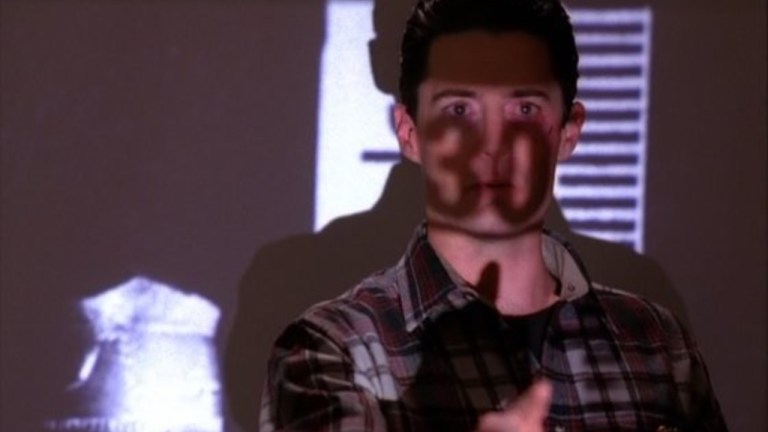Diane Keaton Directed the Most Lynchian Episode of Twin Peaks
Diane Keaton's infamous Twin Peaks episode was something no one else could make, not even David Lynch.

Everything about the Twin Peaks season 2 episode “Slaves and Masters” is strange. There’s the entire infamous final sequence, in which Josie Packard gets turned into a dresser knob, which inspires the Man From Another Place and Bob to show up to mock Copper. There’s the continuation of James Hurley’s femme fatale plotline, more Windom Earle, more Confederate general Ben, more Josie the maid. And there’s the unforgivable decision to make Cooper wear flannel instead of his standard black suit, a sartorial decision that Albert actually compliments for some reason.
But perhaps the weirdest part of all is the last credit that appears in the episode’s opening: “Directed by Diane Keaton.” By 1991, Keaton (who passed away on October 11, 2025) had become the premier off-beat love interest in hip Baby Boomer movies, thanks to her incredible performance in 1977’s Annie Hall.
So what in the world is she doing directing Twin Peaks, a show synonymous with Generation X? Turns out, she was following the show’s co-creator David Lynch, perhaps better than anyone else who directed an episode of the series. Keaton’s episode feels nothing like anything else in the series, and that’s a good thing.
Past Its Peak
In the popular imagination, Twin Peaks is 100% the work of its creators, David Lynch and Mark Frost. Yet, that’s mostly true of the 1992 prequel film Twin Peaks: Fire Walk With Me (with which Frost wasn’t involved) and the revival series Twin Peaks: The Return. The original Twin Peaks was very much a network television show. Lynch directed only six of the 23 episodes (including the pilot), Frost directed only one, and the two creators have writing credits on only 1 combined episodes.
In short, a lot of different people made the first two seasons of Twin Peaks. Many of them were solid television workers: Caleb Deschanel (who, like fellow Twin Peaks director Stephen Gyllenhaal, is today less known than his famous children), Lesli Linka Glatter, Todd Holland, and Tim Hunter are all steady hands, who can make any individual episode feel consistent with the show’s overall tone. Writers Harley Peyton and Robert Engels, the duo who took charge of the series after Lynch and Frost effectively left the production, also tried to maintain the original tone.
But too often, they made Twin Peaks feel like a parody of itself, filling the show with self-consciously wacky bits like the Miss Twin Peaks pageant or anything involving Windom Earle, a dumb person’s idea of a criminal genius. And when Lynch did provide input, he would throw out random ideas like trapping Josie in a dresser knob, and then leave it to others to realize.
Thus, much of Twin Peaks‘s second season is more the work of many people trying to emulate two people than of two people providing a unique vision. And that’s why Keaton’s idiosyncratic take is so notable.
Diane Keaton Made Twin Peaks Her Own
Many of season 2’s terrible plotlines do make their way into “Slaves and Masters.” The episode begins with James Hurley getting framed for murder and ends with Josie’s transformation into furniture. In between, we have to see Josie in a maid’s uniform, Coop in plaid, and Ben in rebel grey.
Yet, somehow, Keaton finds the most visually interesting ways of relating these story beats. She enters several scenes with a moody visual piece, usually consisting of slow motion and dissolves. The episode opens with the camera panning past shots of chess pieces, foregrounding Earle’s game against Cooper. She proceeds Windom Earle’s first scene with a slow-motion close-up of a saw blade cutting a log, mixed with slow-dissolves of gears, before finally settling the camera on actor Kenneth Walsh’s face. She arranges three levels of objects–a hand, the projector, a chess board–in between the camera and a screen for a sequence in which Albert tells Coop about Josie’s criminal past.
Equally compelling are the comedic beats that Keaton brings to the episode. Keaton ends a scene of Ben Horne monologuing as a Confederate General with him leading a sing-along of the Confederate anthem “Dixie.” But she mixes the song with off-key, off-beat singers, drums out of step, and wailing from Ben’s son Johnny, turning the whole thing into a mess as atonal as the storyline itself. Early in the episode, Donna and James try to avoid a police officer who comes to the roadhouse, and the camera follows the cop to a counter filled with other uniformed officers. We watch from the back as every officer turns his capped head toward the newcomer at the same time.
Best of all is the way Keaton finds warmth and humanity in the characters, reminding viewers that even if Lynch and Frost have stepped away, the town is still filled with people we love. A sweet scene finds Ed and Norma lying in bed together, basking in the afterglow of a long-awaited romantic rendezvous. Keaton captures the intimacy of the moment with a strong close-up, first on the face of Ed’s actor Everett McGill and then on Norma’s performer Peggy Lipton. The camera glides from face to face, as the two middle-aged lovers confess their amazement that they’ve been able to reconnect so late in life. Even more impressive is the fact that Keaton shoots the scene in a single, unbroken take, but never distracts attention away from the grounded, emotional work done by her actors.
In each of these examples, Keaton makes the episode strange, funny, and humane. All of those words apply to the way Frost and Lynch handled the series. But Keaton does it in a way totally unlike either of the creators.
Not-Lynchian is Lynchian
David Lynch is an idiosyncratic filmmaker. Only he could turn anxieties over fatherhood into Eraserhead, only he could repurpose a failed TV pilot into Mulholland Drive. And yet, so many filmmakers have tried to emulate Lynch not by also following his idiosyncrasies, but by simply copying him. They’ve implemented checkerboard patterns into dream sequences and they’ve devoted space to off-beat musical sequences and they think they’re doing what Lynch did.
But anyone who has heard Lynch talk about the creative promise knows that the best way to be like Lynch is to not be like him at all. Whenever he talked about what he called the Art Life, he talked about an existence devoted to following one’s own intuitions and nothing else, not even the basic expectations of society. To be an artist is to be totally your self, and not anyone else.
Keaton’s episode of Twin Peaks doesn’t look anything like those directed by Lynch, nor those directed by Glatter or Deschanel or anyone else. And, in that way, Keaton’s episode was the most Lynchian of all.
